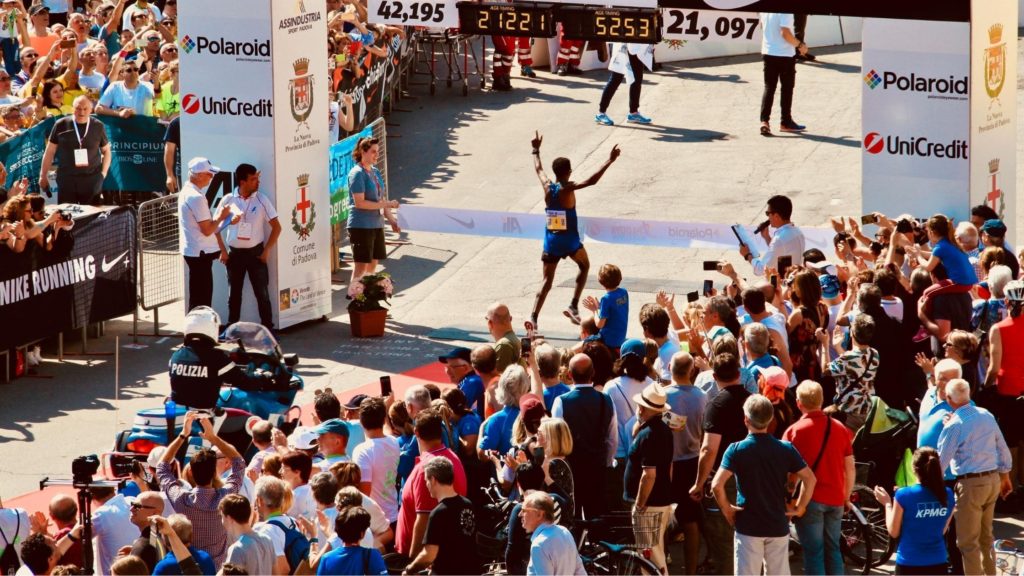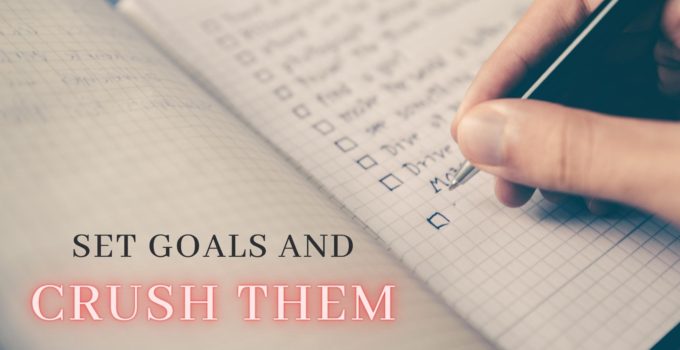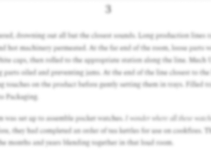I like goals. I like to set them, work on them, and accomplish them. And over time, I’ve learned a really important secret for how to set goals and crush them: dopamine.
Fun fact: that glorious feeling that you get when you cross a task off your to do list? That’s your brain releasing dopamine. A dopamine-flooded brain is a happy brain, and our brains have us trained REALLY well to seek out tasks and experiences that will reward it with that happy chemical.
People who seem to accomplish a ton of things in life, flitting around and crushing goals left and right, have just developed efficient dopamine-delivery systems.
So in order to do the same – set goals, crush them, and move on – you’re going to have to figure out how to create a little dopamine factory in your brain!
What is a goal?
Let’s talk a little about goals. I’ve spent some time scrolling the internet looking at people’s big ol’ lists of goals (and actually wrote one myself), and I’ve seen a HUGE range of interpretation of what a “goal” is. I personally adhere to the SMART goal framework:
- Specific (could you explain it to your mother without an inordinate number of follow-up questions?)
- Measurable (what does success look like?)
- Achievable (does it defy the laws of time or physics?)
- Relevant (does it fit with your other goals or life responsibilities?)
- Time Bound (is there a time frame involved and is it realistic?)
Let’s talk through a couple examples.
In my perusing of life goal lists, I found one that listed “Master the art of conflict resolution” as a life goal.
That’s not a goal, that’s a resolution. And here’s why:
- Specific: In what context are we talking about? Are they wanting de-escalation training? Do they want to be able to get their estranged parents to talk again?
- Measurable: Define “master”.
- Achievable: Eh, I’ll give them this one.
- Relevant: Without knowing the person, I’ll give them this one too.
- Time Bound: Nope. And here, the word “master” is a problem again – how long will mastery take?
Here are some suggestions for better wording:
- Build conflict resolution skills by taking de-escalation training this year
- Practice my conflict resolution skills through facilitating a conversation between my estranged parents in the next three months
Now, you’ll notice that neither of these goals really lend themselves to the mastery this person is clearly after – but after achieving one of these smaller goals, they’ll have an opportunity to reflect and decide what’s next.
But I’m getting ahead of myself. Just know that using the SMART framework allows you to set goals that are easy to crush.
How do you set goals and crush them?
Now that we’ve reviewed what a good goal is, let’s talk about actually writing goals and getting to crushing them!
First, think of a goal you have that you haven’t started working on yet. It could be big (build a grandfather clock!) or small (develop a habit of drinking water). I recently set a goal of learning piano, so I’ll talk you through the steps with that example in mind.
Let’s go.
Step 1: Set a goal to crush.
The first thing you want to do is figure out…what you want to DO. In other words, when you’re done with this goal, what will that look like? How do you want to feel? What do you want to be able to do? How will you know that you can check the goal off the list?
For piano, I realized I want to be able to accompany myself while I sing, and I want to be able to play songs from my favorite 1940s musicals and eventually start a blink-182 acoustic cover band with my brother.
According to the SMART framework, this is Specific and Measurable. It’s a great time to evaluate if the goal is Achievable (I think I could reasonably accompany myself) and Relevant (it fits with my current life and doesn’t conflict with my husband’s well-being).
At this point, don’t worried about the Time portion. That will come later.
Step 2: Break your goal into crush-able chunks.
This is the part where you really start to crush your goals. We’re going to start from the end and work backwards. For this next step, imagine you have already achieved your goal. What was the last thing that you did to finish it?
For me, it’s sitting down at a piano, playing a song and singing along.
What do you need to do in order to make that happen? Make yourself a little backwards plan that outlines each step of the process. Don’t worry about getting this perfect right now – a rough outline of steps is all that you’ll need.
Learn to Accompany Myself on Piano:
- Sit at piano, play a song, sing along
- Learn a song
- Buy the music for the song
- Learn basic piano techniques and skills
- Buy a piano
That’s…about it. And when you start with the end result in mind, it becomes easier to pinpoint the exact steps you need to take. You won’t get distracted along the way with things that would be nice to do (take a piano class and perform in a recital, learn jazz improvisation), but have nothing to do with your goal. Being focused and deliberate in your efforts will allow you to actually accomplish all the things you dream up.
Ok, so now that we know exactly what to do, let’s find time to do it.

I can’t guarantee you’ll run a marathon… but I can’t guarantee you won’t.
[Also, this guy beat my half-marathon time. In a marathon. Hot damn.]
Step 3: Schedule time to crush the goals you set.
Think about your weekly schedule. Do you have 20 minutes somewhere when you’d usually scroll idlily through social media until whatever comes next?
Remember what I was talking about at the beginning about dopamine? Well, scrolling through social media gives us a little bump of dopamine, which is why we tend to do it so much. But you know what also gives us a dopamine boost AND moves us toward our goals?
That’s right: working on our goals.
Think about those 20 minutes. Imagine yourself on the couch, jaw slack, feeling tired and uninspired. If you make the choice to commit just 20 minutes to whatever weird or wonderful goal is bouncing around the back of your head, you’ll find yourself with more energy AND a feeling of accomplishment.
Next, look at the bottom item on your backwards list of tasks. Is it something that you can get done in 20 minutes? If not, break it into smaller steps until the first task is only about 20 minutes.
Then put it on your damn calendar. Commit to yourself and your goal, just for those 20 minutes.
In my example, I realized my tasks were mostly more than 20 minutes, so I broke them down further:
Learn to Accompany Myself on Piano:
- Sit at piano, play a song, sing along
- Learn a song
- Spend 20 min/day for 2 weeks practicing song
- Buy the music for the song
- Learn basic piano techniques and skills
- Research and purchase adult piano beginner course book
- Spend 20 min/day for 6 months working through course
- Buy a piano
- Research keyboards – quality, price points, brands
- Save up for and order keyboard
See how breaking it up into steps makes it really easy to incorporate the Time portion of SMART into your goals?
To be honest, I made up how long it would take me to learn piano or a specific song. I’m notoriously terrible at estimating how long it takes me to do things, so I guessed.
But the next step is how we correct our time guesses – and find more opportunities to set goals and crush them – even when motivation lags.
Step 4: Check to see how well you’re crushing your goals.
Confession time: I completed my “buy a piano” step back in late 2017. I got the beginner piano book for Christmas 2018. Aaaaand then I didn’t start practicing piano consistently until November of 2019. I probably won’t be able to accompany myself on a piece until at least the end of 2020.
But I’ve done a lot of other things in that time (got engaged, married, and moved to Berlin, to name a couple little ones), so I’m comfortable with my piano progress. And I’m comfortable because I regularly check in with my goals.
I highly encourage you to take some time and write down all the goals that you’re currently working on. Look at that list – it’s probably longer than you realized! Between work, self-care, and a social life, you only have so much time left over, so being able to prioritize those goals is key to actually getting any of them done.
Then, choose 1-3 of the goals on your list to focus on. You’ll get to the rest of them later, but really commit to only working on those 1-3 for the next few weeks.
After that, for those 1-3, look at the next 20-minute step, and put it in your calendar.
Finally, check back in after a couple of weeks have passed. Have your priorities shifted? Make sure the 1-3 priorities are the ones you really want to be working on right now.
Step 5: Know when to quit trying to crush that goal.
This step is mostly for Future Katherine to come back to and remind herself.
I’m terrible at quitting. I like to finish things. Ask my husband about the time I forced myself to read Moby Dick – I just needed to be sure that I hated the end as much as I hated the rest of the damn boring book (WHY DO WE NEED TO READ YOUR CLASSIFICATION OF WHALES, MELVILLE? WHY?!)
Anyway, there will come a time when you realize that one of your goals never makes it into the 1-3 priorities. And you want to work on it, but it’s never the ~*thing*~ you want to spend your 20 minutes on.
In those moments, I suggest taking it off the list, because if it’s important to you, it will re-inspire you later and make it back on the list.
But don’t force yourself to work on goals just because you said you would or because someone else did it and you feel like you should too…
Simply focus on what YOU want to do and go do it. After all, it will only take 20 minutes per day to set your goals and crush them.
For more info on crushing goals, check out these other posts:
Set Goals for the Week – and Finally FINISH Things
How Do I Know How Many Goals To Have At A Time?
In Defense of “What gets measured, gets managed.”
The Magic of the Importance/Difficulty Matrix
5 SMART Financial Goal Examples
6 Tips for How to Budget Better
6 Benefits to Being in Charge of Your Finances
A Sticker Chart for Adults: Treat Yourself Like a Kid!




I’m going to put this one into practice to take mike and is goal of going camping regularly from a Vague wish, to something with specific steps agreed to and verbalized by both of us. I don’t know why I didn’t do it before.
Instead I just voiced my concern that I didn’t think we would ever get to it unless I did all the planning. But without measurable goals set out for him mike won’t have markers of if he isn’t doing his end specifically.
Side note: The trick to enjoying Moby Dick is to pair it with the book “adios struck and white” and approach it as the literary equivalent of a needlepoint sampler. Think of it as the opposite of Harry Potter book 1. Harry Potter book 1 has great plot, which is I am willing to slog through the annoyingly basic, blocky, flow-less writing. And don’t get @ me about it’s a children’s book, there are plenty of better written children’s books. Well like I said, Moby Dick is the opposite, the plot lacks all appeal, but the writing that moves you through that plot plays with the content in such beautiful, creative, and even hilarious ways that it’s like watching smoke curl and move through the air—utterly mesmerizing.
From start to finish Moby Dick is a primer for how to play with grammar, punctuation, sentence structure, and word choice. The content is boring. Take a minute to really breakdown what is being done with words, and I promise it will become super invigorating: you will read a paragraph and want to run out and write one just to try out the same tricks.
If you do give it another try in that light and enjoy it more, I highly suggest reading Henry James stories again with a similar focus.
1. I love that you guys are going to go camping more! The step we always get stuck on is, “Where should we go?” because for some reason, we seem to think we need to find a perfect campsite instead of just…any…campsite. So watch out for that – there’s not right answer, just a decided decision.
2. UGH. I hear what you’re saying about Melville and I did enjoy his prose when he was talking about the plot. I just don’t like endless philosophizing or that whole stupid section where he outlines a taxonomy of whales. I haven’t done any James, so maybe I should try your suggestion with one of his and then go back and try Moby Dick again!